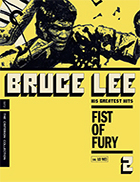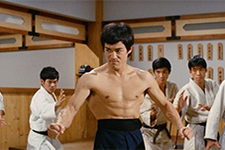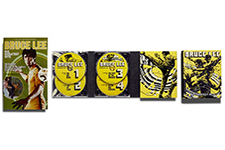| Director: Wei Lo | | Screenplay: Wei Lo | | Stars: Bruce Lee (Chen Zhen), Nora Miao (Yuan Le-erh), James Tien (Fan Chun-hsia), Maria Yi (Yen), Robert Baker (Petrov), Fu Ching Chen (Chao), Shan Chin (Tung), Ying-Chieh Han (Feng Kwai-sher), Chikara Hashimoto (Hiroshi Suzuki), Jun Katsumura (Suzuki’s bodyguard), Chung-Hsin Huang (Tien) | | MPAA Rating: R | | Year of Release: 1972 | | Country: Hong Kong |  |
|  Fist of Fury (Jing wu men), the second of the films martial artist Bruce Lee made when he returned to Hong Kong after spending nearly a decade trying to make it in Hollywood, is a much slicker product than its predecessor, The Big Boss (1971). Of course, Fist of Fury was made after The Big Boss’ record-smashing success had turned Lee into a sudden international star, so it benefited from a larger budget and Lee’s complete control over the fight choreography, which looks and sounds and feels more like what would come to be understood as the Bruce Lee aesthetic, which was subsequently copied and then parodied so much that it is hard to fully appreciate just how radical it was at the time (all that high-pitched yelling, all that graphic slow motion, all that intensity). Unlike The Big Boss, which was set in the present day, Fist of Fury is, like many kung fu films of the 1960s, a period piece, set around the turn of the 20th century. It takes as its starting place the poisoning death of Huo Yuanjia, a real-life historical kung fu master who was especially revered in China for his defeat of numerous foreign adversaries. Lee stars as Chen Zhen, a fictional student of Huo’s who returns for his funeral and seeks vengeance for his death at the hands of the Japanese masters of a competing martial arts school. Lee is in full-throated mode from the film’s opening frames, when he arrives late to the funeral and hurls himself onto the casket as it is being lowered into the ground, wailing in such despair that he has to be knocked out with a shovel. That is the first and last time Chen will be knocked out, as he spends the rest of the film methodically uncovering the truth behind his master’s assassination and killing those responsible. Like The Big Boss, there is an inherent nationalist pride in the film’s narrative, although here it is even more emphatic by drawing attention to the villains being Japanese, with whom the Chinese had been in perpetual conflict throughout the late 19th century. We are also given a Russian heavy named Petrov (Robert Baker), who is working with the Japanese martial artists and represents a particular kind of brute strength that plays as perfect counterpoint to the speed and precision of Lee’s style. Director Wei Lo, who had also helmed The Big Boss, seems to have put more thought and energy into this film, as well, giving it a slicker polish and a more coherent visual style. The fighting is, of course, the main event, but Fist of Fury also allows Lee to flex his considerable comedic chops, as his character frequently dons a disguise to hide his true identity, at one point pretending to be an elderly beggar and at another point a goofy telephone repairman whose appearance and demeanor owe significant debt to Jerry Lewis, one of Lee’s favorite actors. As with The Big Boss, the violence is a mix of the realistic and the fantastical, with Lee’s intense physicality giving the film an undeniable presence that also leaves room for Wei’s preference for hyper-stylized action that defies the laws of physics. If you read much about Lee during this time, the words “angry” and “furious” and “frustrated” frequently pop up to describe his mood. For years he had hit wall after wall in Hollywood, suffering the indignities of racial discrimination because the industry had no way of imagining how a Chinese man could be an action superstar. He was relegated to the supporting role of Cato in the short-lived television series The Green Hornet (1966–67), and he watched helplessly as the starring role in the television series Kung Fu, which he had originated and helped to develop, went to David Carradine, a white American actor. Thus, by the time he returned to Hong Kong, where he had begun his film career as a child in the 1940s, he was full of anger and resentment, and Fist of Fury plays like a massive cathartic release. (One can’t help but think of his character’s dismissal of another martial artist’s missed kick in his 1973 film Enter the Dragon: “What was that? An exhibition? We need emotional content.” For Lee, emotion was central.) Lee’s character is full of rage and vengeance, and he spends much of the film glowering and starring with coiled intensity. While his character in The Big Boss certainly doled out righteous punishment to an army of unambiguous bad guys, in Fist of Fury the violence feels more personal, driven by an internal rage that is partly the character’s, but also partly Lee’s own unleashing of years of frustration. He entered The Big Boss as a barely known entity and exited a superstar. With Fist of Fury, he entered a superstar and exited an icon. | Fist of Fury Criterion Collection Blu-ray |  Fist of Fury is available as part of The Criterion Collection’s Bruce Lee: His Greatest Hits boxset, which also includes The Big Boss (1971), The Way of the Dragon (1972), Enter the Dragon (1973), and Game of Death (1978). Fist of Fury is available as part of The Criterion Collection’s Bruce Lee: His Greatest Hits boxset, which also includes The Big Boss (1971), The Way of the Dragon (1972), Enter the Dragon (1973), and Game of Death (1978). | | Aspect Ratio | 2.35:1 (all films) | | Audio | Mandarin Chinese Linear PCM 1.0 monauralEnglish Linear PCM 1.0 monaural | | Subtitles | English | | Supplements | Audio commentary on The Big Boss by Bruce Lee expert Brandon BentleAudio commentaries on The Big Boss, Fist of Fury, The Way of the Dragon, and Game of Deathby Hong Kong film expert Mike LeederAudio commentary on the special-edition version of Enter the Dragon by producer Paul HellerHigh-definition presentation of Game of Death II, the 1981 sequel to Game of DeathGame of Death Redux, a new presentation of Lee’s original Game of Death footage, produced by Alan CanvanVideo interviews on all five films with Lee biographer Matthew PollyVideo interview with producer Andre Morgan about Golden HarvestVideo program about English-language dubbing with voice performers Michael Kaye and Vaughan SavidgeVideo interview with author Grady Hendrix about the “Bruceploitation” subgenre and a selection of Bruceploitation trailersBlood and Steel, a 2004 documentary about the making of Enter the DragonMultiple programs and documentaries about Lee’s life and philosophies, including Bruce Lee: The Man and the Legend (1973) and Bruce Lee: In His Own Words (1998) Video interview with Linda Lee Cadwell, Lee’s widowVideo interview with actor Jon T. BennVideo interview with actor Riki HashimotoVideo interview with actor Nora MiaoVideo interview with actor Jun KatsumuraVideo interview with actor Robert WallVideo interview with actor Yuen WahVideo interview with actor Tung WaiVideo interview with actor Simon YamVideo interview with director Clarence FokVideo interview with director Sammo HungVideo interview with director Wong JingAlternate opening credits and titles Alternate ending for The Big BossExtended scenes for The Big Boss“Bruce Lee: The Early Years” featurette“Bruce Lee vs. Peter Thomas” featurette The Legacy of the Dragon documentary “Bruce Lee Remembered” featurette The Grandmaster and the Dragon documentaryTrailers, TV spots, and radio spotsEssay by critic Jeff Chang | | Distributor | The Criterion Collection | | Release Date | July 14, 2020 | | | COMMENTS | | It may be hard to believe, but this is the first time all five of Bruce Lee’s starring vehicles have been collected into a single Blu-ray package, and Criterion has pulled out all the stops, giving us new high-definition transfers of all five films and hours upon hours of supplements that should keep even the most ravenous Bruce Lee fan satiated. Let’s start with the presentation of the films themselves: They were all transferred and restored in 4K, with the exception of the theatrical version of Enter the Dragon, which was done in 2K. The Big Boss and Fist of Fury were transferred from the original 35mm camera negatives, although the latter used a 35mm interpositive for the opening credits. The Way of the Dragon and Game of Death were transferred from 35mm internegatives, and Enter the Dragon was scanned from a 35mm interpositive. All of the films look better than they ever have on home video, as the new high-def transfers bring out additional levels of detail and texture that were missing in previous editions, as well as improved color timing that results in more natural looking flesh tones and stronger color saturation. Digital restoration has the films looking virtually flawless, with very few instances of dirt and wear. All in all, the films look great. The soundtracks were transferred from a variety of sources (including from materials held by a number of unnamed collectors), and while many of them (especially the early films) are certainly lacking in technical polish, they are reflective of the original aural experience and should be understood as such. And now, onto the supplements, which are … voluminous. How voluminous? Well, there are supplements on each of the discs for the five films and there are two separate Blu-rays just for supplements. I would be lying if I said I had watched and listened to every minute of it all, but I did get through a lot and would like to note some of the highlights. I really appreciated all of the audio commentaries. Each film features a track by Hong Kong film expert Mike Leeder. The Big Boss features an additional track by Bruce Lee expert Brandon Bentle, and the special edition version of Enter the Dragon features an additional track by producer Paul Heller. Each film also includes a video introduction by Matthew Polly, author of the recently published biography Bruce Lee: A Life and himself a practitioner of kung fu who was the first American to be allowed to study at the Shaolin Temple in China. There are hours of archival video interviews with Lee’s family and collaborators, including his widow Linda Lee Calwell and actors John T. Benn, Robert Wall, and Sammo Hung, among others. There are also some new interviews and programs, including a highly entertaining rundown on the Bruceploitation genre by author Grady Hendrix (along with 13 minutes of trailers for some of the more well-known Bruce Lee knock-offs), an engaging look at the history of Golden Harvest with producer Andre Morgan, and a fascinating program on dubbing the films into English with voice performers Michael Kaye and Vaughan Savidge. There are also multiple documentaries about Lee’s life and philosophies, including Bruce Lee: The Man and the Legend (1973), which weirdly and morbidly spends nearly half an hour on Lee’s death and funeral (all of the footage used in Game of Death appears here) and Bruce Lee: In His Own Words (1998). Other highlights include a high-definition presentation of Game of Death II, the 1981 sequel to Game of Death (not a good film by any means, but it is nice to have it hear for historical context) and Game of Death Redux, a new presentation of Lee’s original Game of Death footage produced by Alan Canvan. There are also alternate opening credits and titles for several films, as well as an alternate ending and extended scenes for The Big Boss. Throw in a making-of documentary about Enter the Dragon, a featurette on Bruce Lee’s early years, and tons of trailers, TV spots, and radio spots, and you have a package that can arguably be labeled as definitive. |
Copyright © 2021 James Kendrick Thoughts? E-mail James Kendrick All images copyright © The Criterion Collection |



 (3)
(3)

 Fist of Fury is available as part of The Criterion Collection’s Bruce Lee: His Greatest Hits boxset, which also includes The Big Boss (1971), The Way of the Dragon (1972), Enter the Dragon (1973), and Game of Death (1978).
Fist of Fury is available as part of The Criterion Collection’s Bruce Lee: His Greatest Hits boxset, which also includes The Big Boss (1971), The Way of the Dragon (1972), Enter the Dragon (1973), and Game of Death (1978). 